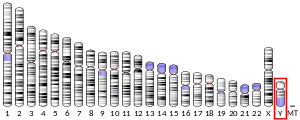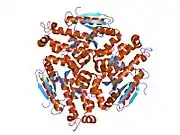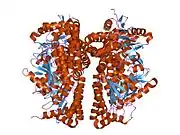| CDY1 | |||||||||||||||||||||||||||||||||||||||||||||||||||
|---|---|---|---|---|---|---|---|---|---|---|---|---|---|---|---|---|---|---|---|---|---|---|---|---|---|---|---|---|---|---|---|---|---|---|---|---|---|---|---|---|---|---|---|---|---|---|---|---|---|---|---|
 | |||||||||||||||||||||||||||||||||||||||||||||||||||
| |||||||||||||||||||||||||||||||||||||||||||||||||||
| Identifiers | |||||||||||||||||||||||||||||||||||||||||||||||||||
| Aliases | CDY1, CDY, CDY1A, chromodomain protein, Y-linked, 1, chromodomain Y-linked 1 | ||||||||||||||||||||||||||||||||||||||||||||||||||
| External IDs | OMIM: 400016 HomoloGene: 36165 GeneCards: CDY1 | ||||||||||||||||||||||||||||||||||||||||||||||||||
| |||||||||||||||||||||||||||||||||||||||||||||||||||
| |||||||||||||||||||||||||||||||||||||||||||||||||||
| |||||||||||||||||||||||||||||||||||||||||||||||||||
| |||||||||||||||||||||||||||||||||||||||||||||||||||
| Wikidata | |||||||||||||||||||||||||||||||||||||||||||||||||||
| |||||||||||||||||||||||||||||||||||||||||||||||||||
Testis-specific chromodomain protein Y 1 is a protein that in humans is encoded by the CDY1 gene.[3][4]
This gene encodes a protein containing a chromodomain and a histone acetyltransferase catalytic domain. Chromodomain proteins are components of heterochromatin-like complexes and can act as gene repressors. This protein is localized to the nucleus of late spermatids where histone hyperacetylation takes place. Histone hyperacetylation is thought to facilitate the transition in which protamines replace histones as the major DNA-packaging protein. The human chromosome Y has two identical copies of this gene within a palindromic region; this record represents the more telomeric copy. Chromosome Y also contains a pair of closely related genes in another more telomeric palindrome as well as several related pseudogenes. Two protein isoforms are encoded by transcript variants of this gene. Additional transcript variants have been described, but their full-length nature has not been determined.[4] The gene is thought to be related to high-altitude adaptation in humans.[5]
References
- 1 2 3 GRCh38: Ensembl release 89: ENSG00000172288 - Ensembl, May 2017
- ↑ "Human PubMed Reference:". National Center for Biotechnology Information, U.S. National Library of Medicine.
- ↑ Lahn BT, Page DC (Nov 1997). "Functional coherence of the human Y chromosome". Science. 278 (5338): 675–80. Bibcode:1997Sci...278..675L. doi:10.1126/science.278.5338.675. PMID 9381176.
- 1 2 "Entrez Gene: CDY1 chromodomain protein, Y-linked, 1".
- ↑ Zhang YB, Li X, Zhang F, Wang DM, Yu J (2012). "A preliminary study of copy number variation in Tibetans". PLOS ONE. 7 (7): e41768. Bibcode:2012PLoSO...741768Z. doi:10.1371/journal.pone.0041768. PMC 3402393. PMID 22844521.
External links
- Human CDY1 genome location and CDY1 gene details page in the UCSC Genome Browser.
Further reading
- Jones DO, Cowell IG, Singh PB (2000). "Mammalian chromodomain proteins: their role in genome organisation and expression". BioEssays. 22 (2): 124–37. CiteSeerX 10.1.1.575.6410. doi:10.1002/(SICI)1521-1878(200002)22:2<124::AID-BIES4>3.0.CO;2-E. PMID 10655032.
- Yen PH (1999). "A long-range restriction map of deletion interval 6 of the human Y chromosome: a region frequently deleted in azoospermic males". Genomics. 54 (1): 5–12. doi:10.1006/geno.1998.5526. PMID 9806824.
- Lahn BT, Page DC (1999). "Retroposition of autosomal mRNA yielded testis-specific gene family on human Y chromosome". Nat. Genet. 21 (4): 429–33. doi:10.1038/7771. PMID 10192397. S2CID 8345990.
- Saut N, Terriou P, Navarro A, et al. (2000). "The human Y chromosome genes BPY2, CDY1 and DAZ are not essential for sustained fertility". Mol. Hum. Reprod. 6 (9): 789–93. doi:10.1093/molehr/6.9.789. PMID 10956550.
- Kleiman SE, Lagziel A, Yogev L, et al. (2001). "Expression of CDY1 may identify complete spermatogenesis". Fertil. Steril. 75 (1): 166–73. doi:10.1016/S0015-0282(00)01639-3. PMID 11163833.
- Ferlin A, Moro E, Rossi A, Foresta C (2001). "CDY1 analysis in infertile patients with DAZ deletions". J. Endocrinol. Invest. 24 (2): RC4–6. doi:10.1007/bf03343814. PMID 11263480. S2CID 22500357.
- Lahn BT, Tang ZL, Zhou J, et al. (2002). "Previously uncharacterized histone acetyltransferases implicated in mammalian spermatogenesis". Proc. Natl. Acad. Sci. U.S.A. 99 (13): 8707–12. Bibcode:2002PNAS...99.8707L. doi:10.1073/pnas.082248899. PMC 124363. PMID 12072557.
- Kostova E, Röttger S, Schempp W, Gromoll J (2003). "Identification and characterization of the cynomolgus monkey chromodomain gene cynCDY, an orthologue of the human CDY gene family". Mol. Hum. Reprod. 8 (8): 702–9. doi:10.1093/molehr/8.8.702. PMID 12149400.
- Strausberg RL, Feingold EA, Grouse LH, et al. (2003). "Generation and initial analysis of more than 15,000 full-length human and mouse cDNA sequences". Proc. Natl. Acad. Sci. U.S.A. 99 (26): 16899–903. Bibcode:2002PNAS...9916899M. doi:10.1073/pnas.242603899. PMC 139241. PMID 12477932.
- Skaletsky H, Kuroda-Kawaguchi T, Minx PJ, et al. (2003). "The male-specific region of the human Y chromosome is a mosaic of discrete sequence classes". Nature. 423 (6942): 825–37. Bibcode:2003Natur.423..825S. doi:10.1038/nature01722. PMID 12815422.
- Dorus S, Gilbert SL, Forster ML, et al. (2003). "The CDY-related gene family: coordinated evolution in copy number, expression profile and protein sequence". Hum. Mol. Genet. 12 (14): 1643–50. doi:10.1093/hmg/ddg185. PMID 12837688.
- Kleiman SE, Yogev L, Hauser R, et al. (2003). "Members of the CDY family have different expression patterns: CDY1 transcripts have the best correlation with complete spermatogenesis". Hum. Genet. 113 (6): 486–92. doi:10.1007/s00439-003-0990-9. PMID 14569460. S2CID 43221279.



